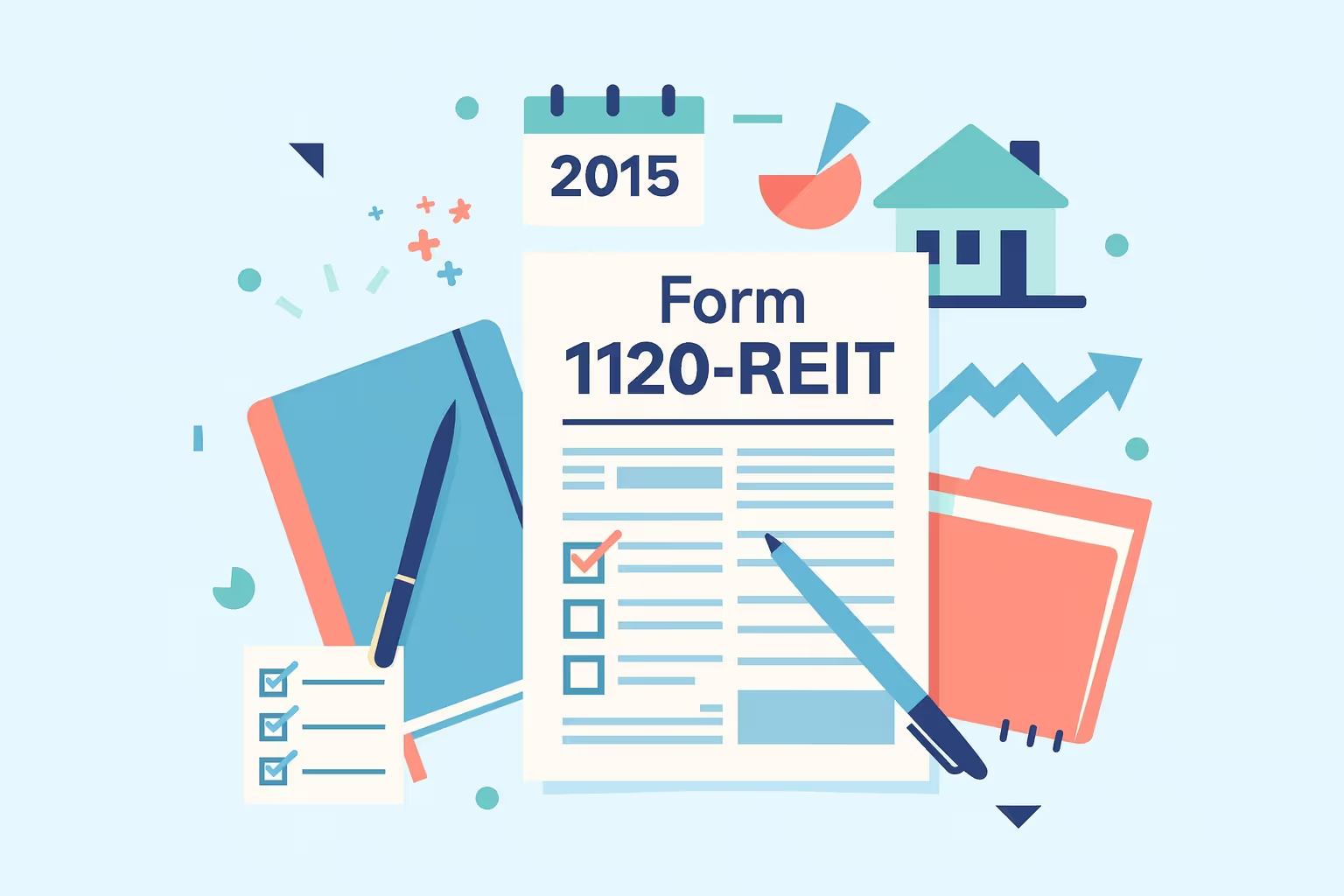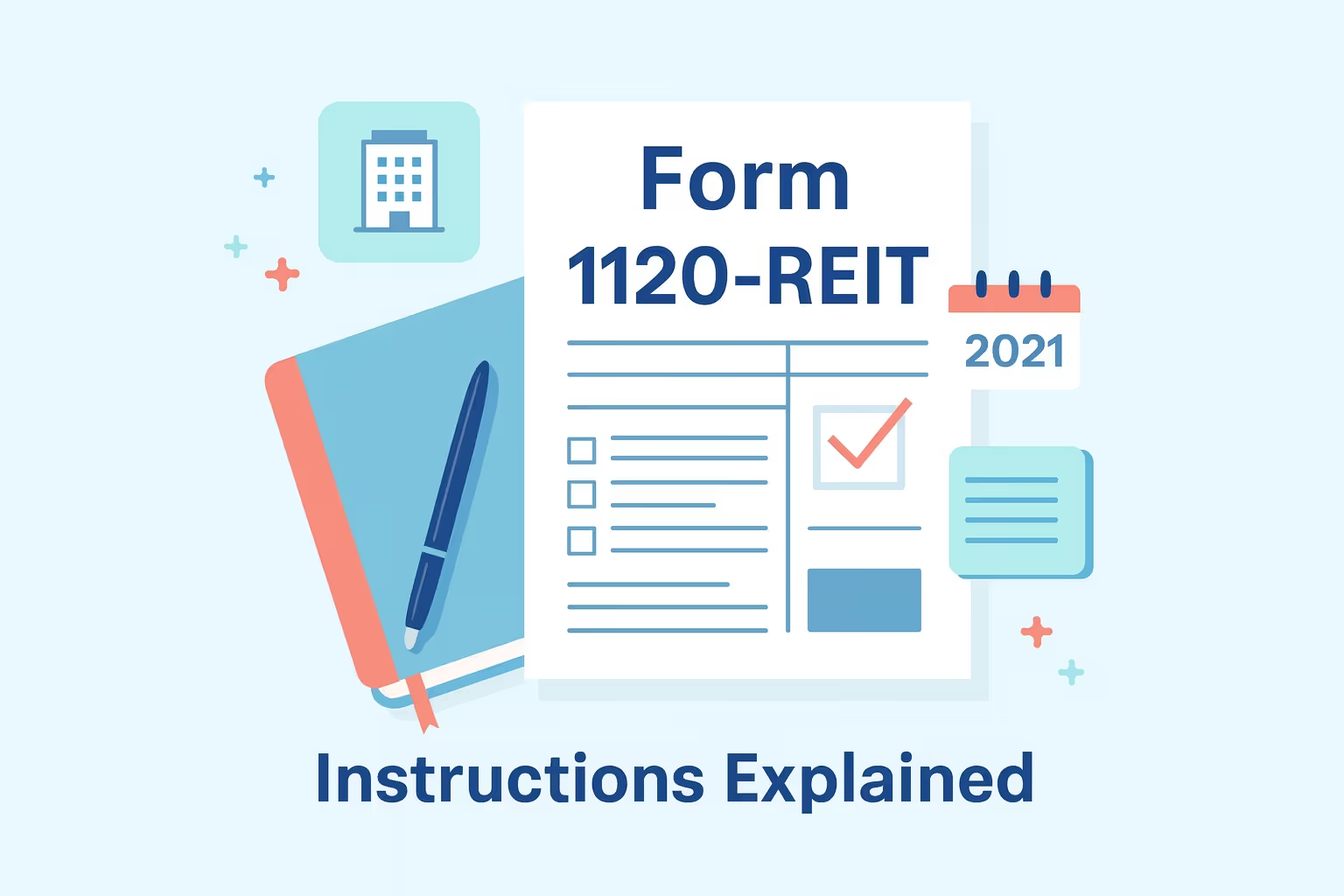
Form 1120-REIT is the official income tax return that real estate investment trusts must file each tax year with the Internal Revenue Service. For 2013, corporations, trusts, or associations that elected to be treated as a REIT were required to complete this form to report income, deductions, and credits while documenting compliance with federal tax rules. The form also helps ensure that shareholders receive the proper record of dividend distributions and that the trust maintains its qualification under the tax code.
The 2013 instructions emphasized that taxpayers must verify their REIT status, calculate taxable income accurately, and follow deadlines to avoid penalties. Filing requirements are applied even to dormant organizations since the election is to be treated as a REIT carries forward until it is terminated. The Internal Revenue Service provided detailed guidance on how to complete each page of the form, as well as rules for calculating estimated tax and meeting distribution tests. These requirements were designed to ensure businesses' compliance and maintain the integrity of the REIT structure.
This guide explains the 2013 filing process step by step, using examples and references directly from the Treasury and IRS publications. It is designed for users who may be unfamiliar with corporate filings but need to understand how to prepare a complete and correct tax return. By reviewing the process clearly, REITs can meet their obligations, respond appropriately to notices, and avoid unnecessary costs or interest.
Understanding Form 1120-REIT
Form 1120-REIT is the income tax return that real estate investment trusts must file with the Internal Revenue Service each tax year. It serves as the official document for corporations, trusts, or associations that have elected REIT status, ensuring they report income, deductions, credits, and distributions in compliance with federal tax law. This filing requirement applies regardless of whether the organization is active or has little income in a given year.
Who Must File Form 1120-REIT?
- A corporation, trust, or association that elects to be treated as a real estate investment trust.
- An organization that made a REIT election in a prior tax year and has not terminated or revoked that election.
- A REIT that continues to meet shareholder and ownership requirements under federal law.
Purpose of Form 1120-REIT
- It reports the taxable income of the REIT to the Internal Revenue Service.
- It documents compliance with REIT qualification tests, including distribution, income, and asset requirements.
- It calculates taxes on foreclosure property, prohibited transactions, and other applicable charges.
- It records distributions to shareholders and provides the IRS with information needed to verify compliance.
The form is more than a standard corporate tax return. It ensures that real estate investment trusts maintain their special tax treatment, which allows them to pass most of their income to shareholders without being subject to double taxation. By completing this form correctly, organizations protect both their own tax status and the interests of their shareholders.
What’s New for 2013?
For the 2013 tax year, the Internal Revenue Service did not introduce significant changes to Form 1120-REIT. However, REITs were required to remain vigilant regarding ongoing compliance rules and regularly check the IRS website for any mid-year updates. The official 2013 instructions emphasized continued use of electronic payment systems, strict adherence to filing deadlines, and compliance with qualification requirements.
Key ongoing requirements included:
- REITs must continue to file on a calendar year basis unless a different fiscal year was adopted before October 5, 1976.
- Electronic tax payments were required through the Electronic Federal Tax Payment System or a financial institution.
- REITs were obligated to distribute at least 90 percent of taxable income to shareholders.
- The 75 percent and 95 percent income tests, as well as the asset qualification tests, remained unchanged for 2013.
By following these rules, REITs can ensure that they meet Internal Revenue Service expectations and avoid penalties for noncompliance.
Step-by-Step Filing Instructions
Step 1: Verify REIT Status and Qualification.
Organizations had to confirm that they met the requirements for REIT treatment. This included maintaining shareholder rules, ensuring shares were transferable, and verifying that the election had been properly made and remained in effect.
Step 2: Gather Required Information.
Filers were required to collect all supporting documentation before commencing. This included income records such as rents, dividends, and capital gains, as well as expense documentation, dividend payment statements, and prior-year returns.
Step 3: Complete the Form Header Information.
The filer was required to provide the legal name, Employer Identification Number, business address, REIT election date, total assets as of year-end, and REIT type.
Step 4: Report Income and Deductions (Part I).
The return required reporting of all applicable income, including dividends, rents, and gains. Deductions such as salaries, taxes, depreciation, and other costs had to be listed in detail. After deductions, the taxable income was calculated.
Step 5: Complete Specialized Tax Sections (Parts II–IV).
These sections applied if the REIT had income from foreclosure property, prohibited transactions, or failed to meet source-of-income requirements. Each section calculated the additional tax liability.
Step 6: Fill Out Required Schedules
- Schedule A: This schedule showed the deduction for dividends paid to shareholders.
- Schedule J: This schedule calculates the total tax owed, including any special taxes.
- Schedule K: This schedule gave general information about the REIT, including ownership and accounting methods.
- Schedule L: This schedule lists the beginning and ending balance sheets for the year.
- Schedule M-1: This schedule explains the differences between book income and taxable income.
- Schedule M-2: This schedule showed changes in retained earnings during the year.
These steps helped filers complete the form systematically and reduce the likelihood of missing information or calculation errors.
Filing Methods and Deadlines
Filing Form 1120-REIT correctly required REITs to follow the instructions provided by the Internal Revenue Service. For the 2013 tax year, taxpayers had the option to choose between electronic filing and paper filing, but electronic submission was generally recommended for its speed and accuracy.
Electronic Filing
- REITs could e-file using IRS-approved software or through a tax professional authorized by the agency.
- Electronic filing reduced processing time, improved accuracy, and provided immediate confirmation that the return had been received.
- Payments made electronically through the Electronic Federal Tax Payment System offered added security, as confirmed by the locked padlock icon displayed during the transaction process.
Paper Filing
- Paper filing was still an acceptable method in 2013, but filers needed to send returns to the correct IRS address based on the REIT’s asset level.
- REITs with less than $10 million in assets mailed their returns to the Department of the Treasury, Internal Revenue Service Center, Cincinnati, OH 45999-0012.
- REITs with assets of $10 million or more mailed their returns to the Internal Revenue Service Center, Ogden, UT 84201-0012.
- All attachments had to be assembled in the proper order as determined by the IRS, including schedules, statements, and supporting forms.
Deadlines
- The due date for filing Form 1120-REIT was the 15th day of the third month after the close of the tax year. For calendar year filers, this meant March 15, 2014.
- If the due date fell on a weekend or legal holiday, the deadline moved to the next business day.
- REITs could request an extension to file by submitting Form 7004, but the extension only applied to the return itself. All tax payments remained due on the original date.
Practical Filing Tips
- Filers had to verify the Employer Identification Number, organization name, and business address before submitting.
- All required schedules and pages had to be completed, signed, and dated by an authorized officer of the REIT.
- Keeping copies of the return, payment confirmations, and related correspondence helped taxpayers respond effectively if the Internal Revenue Service issued a notice or request for additional information.
By following these filing methods and observing deadlines, businesses reduced the risk of penalties, interest, and rejected returns. Careful preparation also ensured that the return honored REIT election status and complied with all applicable agency rules.
Payment Instructions
For the 2013 tax year, all REITs were required to make tax payments electronically. The Internal Revenue Service directed taxpayers to use the Electronic Federal Tax Payment System or an approved financial institution to ensure timely deposits. This requirement applied to both the balance due with the return and any estimated tax installments that were outstanding.
When Payments Were Due
- Tax payments were due by the 15th day of the third month after the close of the tax year. For calendar-year filers, the deadline was March 15, 2014.
- REITs with a tax liability of $500 or more were required to make quarterly estimated tax payments. These payments were due on April 15, June 15, September 15, and December 15.
Accepted Payment Methods
- Payments could be made directly from the REIT’s bank account using the Electronic Federal Tax Payment System.
- REITs could also submit payments through a participating financial institution that the Treasury Department authorized.
- An authorized tax professional could make an electronic payment on behalf of the REIT using IRS-approved systems.
Maintaining proper records of all payments was essential. These records allowed taxpayers to verify compliance and respond to any IRS notice regarding underpayment or missing deposits.
Required Schedules and Attachments
Form 1120-REIT required specific schedules and attachments that supported the calculation of income, deductions, and credits. Filing these documents in the correct order ensured that the IRS could review the return efficiently and determine compliance with REIT rules.
Mandatory Schedules
- Schedule A documented the deduction for dividends paid and required filers to provide detailed information about distributions to shareholders.
- Schedule J calculated the total tax liability, including any special taxes applicable to foreclosure properties or prohibited transactions.
- Schedule K gathered general information about the REIT, such as ownership details, accounting methods, and compliance questions.
- Schedule L presented balance sheets per books at the beginning and end of the tax year.
- Schedule M-1 reconciled book income with taxable income, showing differences between financial reporting and tax reporting.
- Schedule M-2 tracked changes in retained earnings during the year.
Conditional Attachments
- Form 4562 was required to claim deductions for depreciation and amortization of assets.
- Form 4797 had to be filed if the REIT sold business property and needed to report gains or losses.
- Form 1125-E was necessary if officers received compensation that must be disclosed.
- Form 8612 applies if the REIT owes excise tax on undistributed income.
- Schedule D was required when reporting capital gains and losses from investments.
By assembling schedules and attachments in the order required by the Internal Revenue Service, taxpayers reduced the risk of delays or rejections.
Common Filing Mistakes to Avoid
Errors in completing Form 1120-REIT were a frequent cause of penalties and additional correspondence with the Internal Revenue Service. These mistakes often delayed refunds or led to interest charges on unpaid balances.
- Some filers submitted forms with an incorrect or missing Employer Identification Number, which prevented the IRS from matching the return with the correct organization.
- Others left required schedules incomplete or failed to include conditional attachments when applicable. This omission made the return inaccurate.
- REITs sometimes miscalculated deductions or the dividend distribution amount, which led to underreporting of taxable income or incorrect credits.
- Failure to make proper estimated tax payments resulted in underpayment penalties and additional costs.
- Returns that were not signed or dated by an authorized person were considered incomplete and may have been rejected.
Mistakes also occurred when calculating REIT qualification tests. Misreporting the 75 percent and 95 percent income tests or the 90 percent distribution requirement often led to compliance issues.
Errors in reporting income from prohibited transactions or foreclosure property created further tax liability. Carefully reviewing instructions, verifying figures, and ensuring that all pages and attachments were complete helped taxpayers avoid these problems. A thorough review reduced the chances of notices, penalties, or interest charges.
Zero Activity or Dormant REIT Filing
Even if a real estate investment trust had no income or limited activity during the tax year, it was still required to file Form 1120-REIT. The election to be treated as a REIT remained in effect until it was formally terminated, which meant that the filing requirement continued, regardless of the business activity.
Filing Requirements for Dormant REITs
- A REIT with zero income was required to file Form 1120-REIT by the regular due date, which was March 15 for calendar-year organizations.
- All mandatory schedules still had to be completed, even if figures were zero. This ensured the IRS could verify compliance with REIT rules.
- Dormant REITs were required to maintain shareholder information and confirm that organizational requirements were still in place.
Terminating REIT Status
- A REIT that wished to end its election had to file a final Form 1120-REIT and check the “Final return” box.
- Once REIT status was terminated, the organization had to file a standard corporate income tax return on Form 1120 for subsequent years.
- Re-election was not allowed for five years without approval from the Internal Revenue Service.
Filing in dormant years demonstrated compliance and preserved the ability to maintain REIT tax treatment. It also helped avoid penalties for non-filing and maintained the organization's good standing with the agency.
First-Time Filer Guidance
Organizations filing Form 1120-REIT for the first time faced several essential preparation steps. Meeting these requirements helped prevent errors and ensured the Internal Revenue Service accepted the return.
Pre-Filing Checklist
- The organization had to obtain an Employer Identification Number if it did not already have one.
- A valid Electronic Federal Tax Payment System account was necessary to make the required payments.
- Supporting documents such as income statements, dividend payment records, and asset valuations had to be collected before starting the form.
- The REIT qualification requirements, including shareholder and ownership rules, had to be verified before filing.
Key Focus Areas for New REITs
- The REIT election must be made appropriately by filing Form 1120-REIT and following the applicable instructions.
- The organization needed to understand the 75 percent asset test and both the 75 percent and 95 percent income tests.
- A dividend policy had to be in place to meet the 90 percent distribution requirement.
- Recordkeeping procedures were essential for tracking income, deductions, and distributions.
Second-Year Requirements
- Beginning in the second tax year, REITs were required to meet the 100-shareholder test.
- They also had to ensure the organization was not closely held, as defined by federal tax law.
Proper preparation and documentation gave first-time filers confidence that their return was complete and accurate. It also reduced the risk of IRS notices or penalties.
Frequently Asked Questions
What are the Form 1120-REIT 2013 instructions?
The Form 1120-REIT 2013 instructions outline the procedures for filing the annual income tax return of real estate investment trusts with the Internal Revenue Service. They provide guidance on calculating taxable income, applying deductions and credits, and meeting distribution requirements. The instructions also describe due dates, payment options, and filing methods. By following the correct page order and including all applicable schedules, taxpayers can file a complete return, avoiding penalties or delays.
How do estimated tax payments apply to REITs?
REITs must pay estimated tax if their total income tax is $500 or more for the tax year. These payments are due in four installments, typically on April 15, June 15, September 15, and December 15. Payments can be made through the Electronic Federal Tax Payment System or a financial institution acting on behalf of the organization. Making timely estimated tax payments helps taxpayers avoid interest, underpayment charges, and unnecessary costs.
What happens if a REIT misses the due date?
If a REIT misses the due date for filing its income tax return, the IRS may impose penalties and interest. Penalties are calculated as a percentage of the unpaid tax balance, and interest continues to accrue until the tax balance is paid. Even if no income is earned, a REIT must file to honor its election. Requesting an extension with Form 7004 allows more time to file, but all tax payments remain due on the original date.
Do partnerships or S corporations file Form 1120-REIT?
No, partnerships and S corporations do not file Form 1120-REIT. Instead, they report partnership income or the partner’s share of income on their respective returns. Form 1120-REIT is only applicable to corporations, trusts, or associations that elect to be treated as real estate investment trusts. Businesses must verify the correct form before filing to avoid penalties. The Internal Revenue Service provides examples and instructions for each type of organization.
Can taxpayers claim a refund or respond to an IRS notice?
Yes, if a REIT overpays, it may claim a refund on its income tax return. If the Internal Revenue Service issues a notice regarding errors, missing attachments, or incorrect figures, the organization must respond by the stated date. Filers should review instructions carefully, verify calculations, and submit a clear statement with corrected information. Responding promptly helps taxpayers avoid additional charges and ensures that refunds or credits are processed accurately by the agency.



































